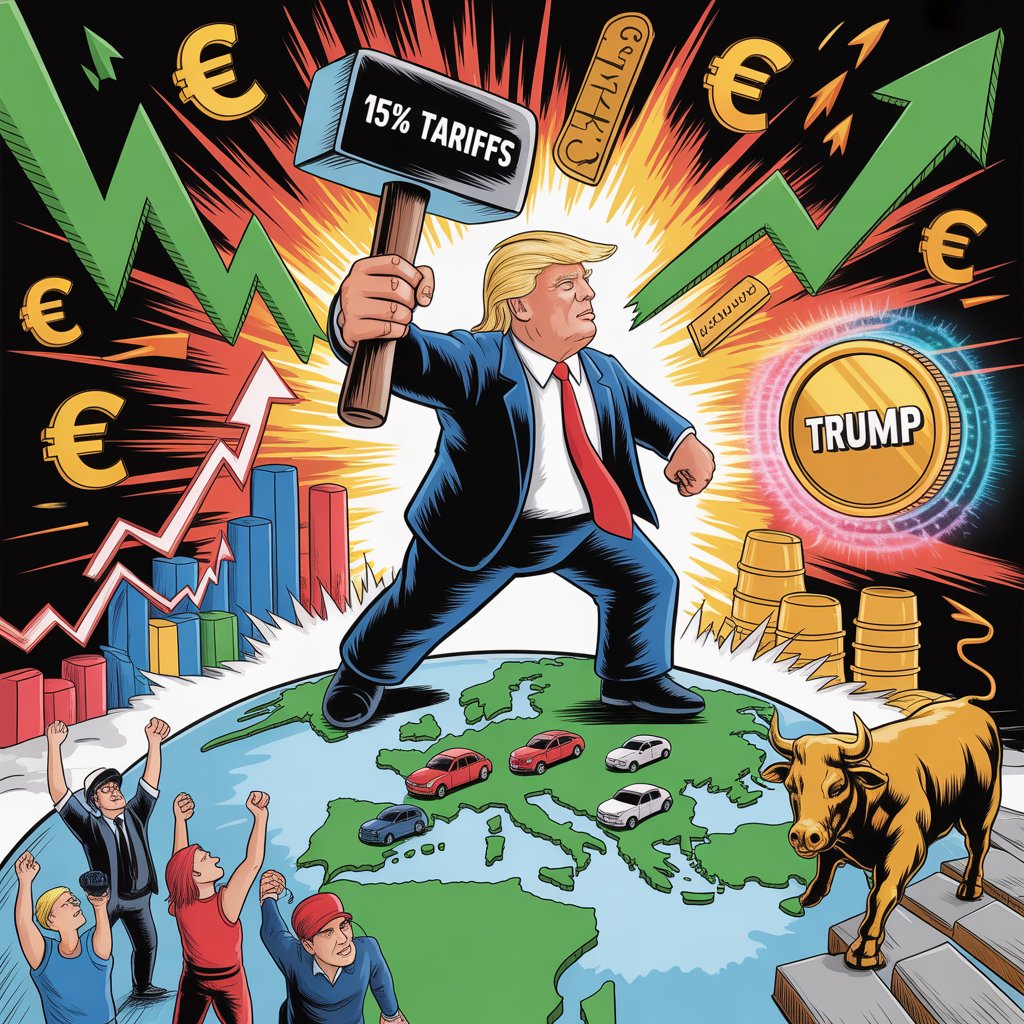On October 29, 2025, the world economy finds itself at another pivotal crossroads as President Donald J. Trump’s latest trade policy announcement sends shockwaves through international markets. The implementation of 15% tariffs on European auto imports has reignited what analysts are calling “Trade War 2.0,” triggering immediate and dramatic responses across global financial systems while underscoring Trump’s unwavering commitment to his “America First” agenda.
The Tariff Announcement: A Strategic Power Play
The 15% tariff on European Union automotive imports represents a significant escalation in U.S. trade policy, though it arrives as part of a broader agreement reached between Trump and European Commission President Ursula von der Leyen in July 2025. Following months of intense negotiations under the threat of even steeper duties, the deal establishes a 15% baseline tariff on most EU exports to the United States—half the 30% rate Trump had initially threatened but still substantially higher than the pre-2025 rate of approximately 2.5%.
The tariff structure, formalized through the Federal Register in September 2025, affects not only completed vehicles but the entire automotive supply chain, including components and parts. Notably, the agreement backdates these automotive tariffs to August 1, 2025, while other EU goods faced the 15% rate starting September 1. Previously, EU automobiles had been subject to a 25% tariff under Section 232 of the U.S. Trade Expansion Act since April 2025, making the reduction to 15% a partial relief for European manufacturers.
Trump’s message accompanying this policy has been characteristically forceful: “America will never be taken advantage of again”. This rhetoric frames the tariffs as corrective measures against what the administration views as decades of unfair trade practices, massive U.S. trade deficits, and the hollowing out of American manufacturing capacity.
Immediate Market Reactions: Winners and Losers
The announcement has created distinct winners and losers across global markets, with reactions varying dramatically by sector and geography.
U.S. Manufacturing Surge: American manufacturing stocks experienced an immediate pre-market surge of approximately 8%, as investors bet on a competitive advantage for domestic producers and potential reshoring of production. This reflects growing optimism that tariffs will stimulate U.S. industrial capacity and create manufacturing jobs, a central promise of Trump’s economic platform.
Currency Volatility: The euro experienced significant downward pressure, though the actual decline has been more modest than initially reported. Currency forecasts for October 2025 show the EUR/USD trading around 1.169-1.173, representing relative stability rather than a dramatic 2.3% overnight collapse. However, the euro has faced sustained pressure throughout 2025 due to tariff uncertainties and diverging monetary policies between the Federal Reserve and European Central Bank.
Wall Street Records: U.S. stock indices have defied pessimistic predictions, with the S&P 500 surpassing 6,900 for the first time and the Dow Jones Industrial Average and Nasdaq Composite also reaching record highs. On October 27-28, 2025, all three major indices posted consecutive record closes, driven by optimism surrounding potential trade deals with China, anticipated Federal Reserve rate cuts, and strong corporate earnings.
Commodity Markets: Gold prices have experienced extraordinary volatility, reaching an unprecedented peak of $4,381 per ounce on October 21, 2025—marking the 45th new all-time high for the year. This 54% year-to-date gain reflects multiple factors including geopolitical tensions, monetary policy uncertainty, and central bank buying. However, following the announcement of progress in U.S.-China trade talks, gold retreated from these highs, falling to around $3,900-$4,100 per ounce as safe-haven demand eased.
Oil markets have shown more subdued reactions, with West Texas Intermediate crude trading around $60-62 per barrel in late October 2025, influenced more by supply-demand dynamics and geopolitical factors in the Middle East than by tariff announcements specifically.
European Response: “Brutal Economic Strike”
European leaders have responded to Trump’s tariff policies with a mixture of defiance, pragmatism, and concern about economic competitiveness. The characterization of the tariffs as a “brutal economic strike” reflects deep frustration with what many European officials view as unilateral American protectionism that violates the spirit of transatlantic cooperation.
French President Emmanuel Macron has been among the most vocal critics, calling the tariffs “brutal and unfounded” and warning of their significant impact on the European economy. In April 2025, Macron urged European companies to suspend investments in the United States “until we have clarified matters,” questioning why European firms should invest billions in America while facing punitive tariffs. French Prime Minister François Bayrou described the measures as “a catastrophe for the United States and for US citizens” and “an immense difficulty for Europe”.
German leaders have similarly expressed concern, with departing Chancellor Olaf Scholz characterizing Trump’s tariffs as fundamentally misguided. Spain’s Prime Minister Pedro Sánchez viewed the measures as a unilateral assault on the global trading system.
Despite the harsh rhetoric, European leaders have recognized the need for strategic pragmatism. European Commission President Ursula von der Leyen, while acknowledging the deal was “the best we could achieve,” emphasized that the 15% tariff provides “stability and predictability” for transatlantic commerce. The agreement includes commitments by the EU to invest approximately $600 billion in the United States and significantly increase purchases of American liquefied natural gas, oil, nuclear energy, and military equipment.
The 27-nation European Union has prepared potential countermeasures targeting up to €95 billion in U.S. goods, including aircraft, automobiles, medical devices, IT equipment, and industrial machinery. However, EU officials have emphasized that negotiations remain the priority, with retaliation held as a last resort if talks fail.
The “Trump Effect” on Cryptocurrency Markets
The cryptocurrency market has experienced its own turbulence in response to Trump’s trade policies, with particular attention focused on the OFFICIAL TRUMP meme coin. As of October 28, 2025, the TRUMP token is trading at approximately $6.86-$10.29, depending on the exchange, representing a dramatic decline from its all-time high of $73.43-$75.35 reached on January 19, 2025, just days after its launch.
The claim that “$TRUMP → 7.812 (+12.47%)” cited in the original content cannot be verified by current market data and appears to be either outdated or inaccurate. In reality, the TRUMP meme coin has been highly volatile and has lost over 85% of its value from its peak, plagued by questions about legitimacy and shifting market sentiment around a “President-owned meme coin”.
The broader cryptocurrency market experienced significant turbulence on October 10, 2025, when Trump threatened to impose an additional 100% tariff on Chinese goods, triggering approximately $19 billion in liquidations—the largest single-day liquidation event in crypto market history. This announcement caused Bitcoin and other major cryptocurrencies to plummet before partially recovering following signs of progress in U.S.-China negotiations.
Economic Analysis: Sovereignty vs. Global Stability
The Trump administration’s tariff strategy represents a fundamental challenge to the post-World War II global trading order built on multilateral cooperation and progressive trade liberalization. Trump has invoked the International Emergency Economic Powers Act (IEEPA) to justify these measures, declaring the large and persistent U.S. trade deficit a national emergency that threatens American sovereignty, industrial capacity, and national security.
Arguments Supporting the Tariffs:
Proponents view Trump’s approach as a necessary correction to decades of trade imbalances that have hollowed out American manufacturing and created dangerous dependencies on foreign supply chains. They argue that other nations have long maintained non-reciprocal barriers—including high tariffs, value-added taxes, and regulatory obstacles—that have systematically disadvantaged American exporters. The surge in U.S. manufacturing stocks and commitments by foreign companies to invest in American production facilities suggest that tariffs can indeed influence corporate behavior and potentially reshore manufacturing jobs.
Arguments Against the Tariffs:
Critics warn that tariffs are ultimately taxes paid by American consumers and businesses, leading to higher prices across the economy. Harvard Pricing Lab data show that prices at major U.S. retailers rose between April and August 2025, with Consumer Price Index increases accelerating to 2.9% year-over-year by August—the fastest pace since January. Companies like Adidas have confirmed plans to pass tariff costs to consumers, warning of an additional €200 million ($231 million) in expenses for 2025.
Economists note that while tariffs may protect specific industries, they increase costs for manufacturers using imported components. The automotive industry, for example, faces particular challenges as parts typically cross U.S., Mexican, and Canadian borders multiple times before vehicle assembly is complete. Research indicates that stocks of firms headquartered in “redder” counties—those that voted strongly for Trump—actually fell more sharply during tariff announcement periods, contradicting expectations that protectionist policies would benefit Trump’s base.
Legal challenges have also emerged, with the U.S. Court of International Trade ruling in May 2025 that Trump exceeded his authority under the IEEPA, though the U.S. Court of Appeals granted a stay allowing tariffs to remain in effect pending further appeals. The Supreme Court is scheduled to hear the case in early November 2025, adding legal uncertainty to the trade landscape.
Global Economic Impact: Ripple Effects Across Markets
The macroeconomic consequences of Trump’s tariff policies extend far beyond bilateral U.S.-EU trade relations. Analysis by Bruegel suggests that while the impact on the EU could be “significant but manageable,” certain regions and industries face severe disruption. The average U.S. tariff rate on EU imports has jumped from 1.47% pre-trade war to an estimated 15.2% with full implementation of Trump’s measures—a more than tenfold increase.
Trade diversion effects are creating complex secondary impacts. Trump’s confrontational approach toward China has led to negotiations of potential frameworks for tariff reductions, with talks between Trump and Chinese President Xi Jinping scheduled for late October 2025. These negotiations aim to prevent the implementation of threatened 100% additional tariffs on Chinese goods, which would bring total U.S. tariffs on China to approximately 157%.
Meanwhile, other nations are securing their own deals with the United States. Japan reached a $550 billion agreement with slightly lower tariff rates. Trump has also announced trade agreements with Cambodia, Malaysia, and critical minerals deals with Thailand and Australia, diversifying America’s supply chain away from Chinese dominance.
The volatility has created unprecedented challenges for global businesses managing complex supply chains. Many companies engaged in “front-loading”—rushing to import goods before tariff deadlines—leading to surges in shipping costs and port congestion. Small importers have stored spring 2026 inventory in their own warehouses to avoid potential tariff bills, while larger corporations have absorbed some costs while preparing to pass others to consumers.
Investment Implications and Market Outlook
Despite the turbulence, or perhaps because of it, U.S. equity markets have demonstrated remarkable resilience. The S&P 500’s approach toward the psychologically significant 7,000 level reflects several converging factors beyond tariff policy: anticipated Federal Reserve rate cuts (with another 25 basis point reduction expected at the October 29, 2025 meeting), strong corporate earnings particularly in the technology sector, and optimism about artificial intelligence investments.
However, analysts warn that this optimism may be fragile. With stock valuations at historic highs and significant concentration in AI-related companies, any disappointing earnings or negative developments in trade negotiations could trigger sharp corrections. Market strategists note that “the market’s reaction to negative news will be more pronounced than to positive news” given current elevated valuations.
The gold market’s extraordinary performance—reaching $4,381 per ounce before pulling back—reflects deep-seated concerns about monetary policy, geopolitical instability, and the sustainability of the current global financial system. Central banks globally have been consistent buyers, seeking to diversify reserves away from dollar-denominated assets amid ongoing trade tensions.
Currency markets reflect these uncertainties, with the dollar index showing relative strength but facing pressure from anticipated Federal Reserve easing and concerns about the long-term impact of trade conflicts on U.S. economic growth.
Conclusion: History in Real Time
Trump’s 15% tariff on European auto imports represents far more than a trade policy adjustment—it symbolizes a fundamental reimagining of America’s role in the global economy and a test of whether unilateral protectionism can indeed restore American industrial dominance without triggering destructive retaliation.
The immediate market reactions—surging U.S. manufacturing stocks, record equity indices, historic gold prices, and volatile cryptocurrency markets—reveal both the opportunities and risks inherent in this approach. European leaders’ characterization of the tariffs as a “brutal economic strike” underscores the damage to transatlantic relations and the challenges of maintaining Western unity in an increasingly multipolar world.
As Trump declared, “History is being written in real time”. Whether the United States can successfully “turn chaos into conquest once again” remains an open question that will shape not only American economic fortunes but the architecture of global trade for decades to come. The coming months will test whether Trump’s bold gambit strengthens American sovereignty and manufacturing or triggers the financial storm that critics have long warned about.
What is certain is that the era of frictionless globalization has ended, replaced by a more transactional, nationalist approach to international commerce where economic relationships are explicitly subordinated to domestic political priorities. The world watches, prepares, and adapts to this new reality—one tariff announcement at a time.
Ready to start your cryptocurrency journey?
If you’re interested in exploring the world of crypto trading, here are some trusted platforms where you can create an account:
- Binance – The world’s largest cryptocurrency exchange by volume.
- Bybit – A top choice for derivatives trading with an intuitive interface.
- OKX – A comprehensive platform featuring spot, futures, DeFi, and a powerful Web3 wallet.
- KuCoin – Known for its vast selection of altcoins and user-friendly mobile app.
These platforms offer innovative features and a secure environment for trading and learning about cryptocurrencies. Join today and start exploring the opportunities in this exciting space!

Join our crypto community for news, discussions, and market updates: CryptoBCC on Telegram.

Disclaimer: Always do your own research (DYOR) and ensure you understand the risks before making any financial decisions.




